
Wikimedia Commons
I don’t like academic writing. It’s mostly nonsense.
A few years ago, I said as much to my father who works in academia. Despite my insensitivity and lack of tact, I stand by my belief. Not because I’m incapable of admitting when I’m wrong. But because academic writing’s verbose language, impersonal tone, and dispassionate delivery ultimately fail to engage readers.
In other words, “Academics are really good at writing books that only academics will read, but they’re not very good at making anyone outside of academia care,” says Jared Bauer, co-creator of Thug Notes, in an interview with Huffington Post. “Teaching isn’t easy, so I’m not trying to shame teachers for not trying more radical approaches to literature education,” he adds. “But at the very least, I hope (our) show makes teachers realize that a student won’t volunteer their attention. The teacher must seize it.”
As I debated with my father that day, for writing to succeed, it must capture the reader’s attention. If it doesn’t, the writing won’t get shared, influence can’t happen, and the opportunity to learn is squandered, even among scholars. There’s no point to that kind of writing other than to serve as a reminder of how not to write. Continue reading…

This is a fascinating long-read by Madeleine Aggeler: “The Liver King does own shirts, first of all. Several, he claims. I haven’t personally seen them, because when he greeted me in the cavernous entryway of his Texas mansion, he wasn’t wearing one. Nor did I see any in his closet later, which—though it contains approximately 900 identical pairs of athletic shorts and enough guns and ammunition to arm the military of a smaller nation—did not seem to contain even a single t-shirt. Nonetheless, he assured me that there are a few in there, somewhere. It was a bit like when a sign at a national park tells you there are mountain lions in the woods: You believe it, but you understand that you’re unlikely to cross paths with any.” Continue reading…

Courtesy lassedesignen/Shutterstock
I’m convinced there are two types of creators in this world: genius ones and everybody else. By my estimation, 99% of us fall into the latter category, myself very much included. As such, we must play by different rules. Continue reading…
[youtube]http://www.youtube.com/watch?v=FVkH9Hgvda4[/youtube]
Using iOS is still less of a pain than using Android. That is, the form is still better.
But that doesn’t change the fact that the attached ad is incredibly effective in speaking to the majority of smartphone users who don’t appreciate, nor do they want to associate with, the millions of off-putting Apple fans parodied above.
In any case, wouldn’t it be great if phones could go back to being useful tools rather than modern day golden calves?
 I’ve purchased a lot of product in my life. And if there’s one selling point that gets me more than anything else, it’s something that’s “built from the ground up.”
I’ve purchased a lot of product in my life. And if there’s one selling point that gets me more than anything else, it’s something that’s “built from the ground up.”
Whenever I read this, all my consumer concerns melt away. I hate nothing more than buying something that’s built from the ceiling down — or worse, built upon or added to something that already has a sound foundation.
Now I realize some people may glaze over this cliche. Not me. It’s irreversibly tied to the action of me removing my wallet and reaching for plastic. Hook, line, and sinker.
Great video, particularly from 2-5 minutes.
[youtube]http://www.youtube.com/watch?v=JJFqRcvq3rw[/youtube]
Samsung sponsored this guy Kenton Cool (awesome name) to summit Mount Everest for a ninth time this month. In exchange, the company had him place the first cell phone call ever from the highest point on Earth, to his wife. What a moment.
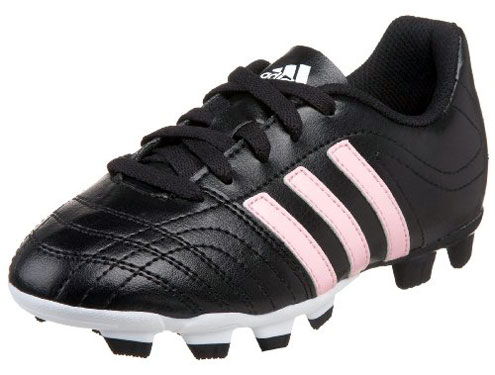
See those three stripes? They’re called “diva,” not pink, according to Adidas. And the white you see is “running white,” as opposed to idle white. I know because that’s what the box on my kitchen counter says. (They’re not for me, mind you, but the little soccer player I father.)
Adidas isn’t the first shoe manufacturer to use confusing names. I’ve seen red called “fire” on Nikes and blue called “ice” on Reeboks.
The silliness makes me wonder: Could shoe manufacturers sell more shoes by using color names people understand? Granted, people don’t shop by shoe boxes; they shop by display. But I imagine some prospective buyers have crossed an unsuspecting color and decided to pass on it. I know for a fact that ambiguity always hurts your chances.
That said, is there any proof that unconventional (or idiotic) color naming boosts sales? I doubt it.
Either way, at least Adidas got the hueless color right when describing the above shoes. They call it “black.”
[youtube]http://www.youtube.com/watch?v=jE4Fcl7oGQc[/youtube]
Mixing camping with must-see TV?
Honestly, how much could this fan be “enjoying” a game of football on a three inch screen while camping, especially since he probably has 50″ HDTV at home? Grow a pair and pick one: Get away from it all in the great outdoors or stay home to watch a game you’re really interested in. Or if you must, DVR.
Seriously, what kind of sick society are we turning into? The equation is simple.
See also:
[youtube]http://www.youtube.com/watch?v=bjK-0dhdIg0[/youtube]
Because sitting through a two-hour moving on a single sofa is so hard these days. Or waiting for popcorn to pop while a movie is paused is excruciatingly slow.
DirecTV’s response: “We better make it easy for people to pause dramatic movie scenes between kitchen, living room, bathroom, and bedroom TVs. It’s not like they’re going to want to stay engaged in said scenes anyway. Who are we to deny people continuous movies during potty breaks? Now let’s go sell this dumb idea! There’s a sucker born every minute!”
Multi-room viewing is retarded use of technology.
DISCLOSURE: I don’t subscribe to any TV service. (Over-air HD and Internet TV only).
 After Tiger Woods took “extramarital affairs” to new lows this year, numerous sponsors canceled their contracts with the once role model, including Gatorade, AT&T, General Motors, Accenture, Tag Heuer, and Gillette. Out of all his major sponsors, only two “stood by” his sleaziness, including Nike and Electronic Arts.
After Tiger Woods took “extramarital affairs” to new lows this year, numerous sponsors canceled their contracts with the once role model, including Gatorade, AT&T, General Motors, Accenture, Tag Heuer, and Gillette. Out of all his major sponsors, only two “stood by” his sleaziness, including Nike and Electronic Arts.
Today, the latter is wishing it hadn’t. Continue reading…
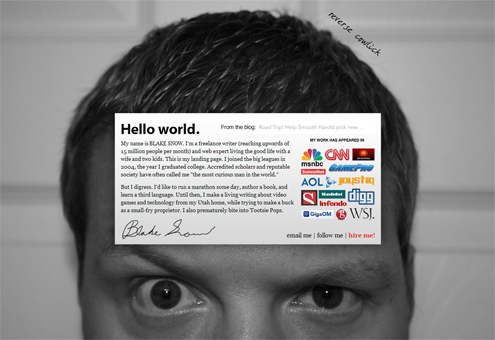
In an effort to centralize my online identity, I launched BlakeSnow.com this week. The site features state of the art HTML, some fancy javascript animation, and an enlarged photo of my shapely cranium. I’ll still be blogging under my pseudonym here, and maintain other websites as well, but this will serve as an entry point for people who don’t know me. Plus it makes me look cooler than I really am.
(Thanks, Robert)
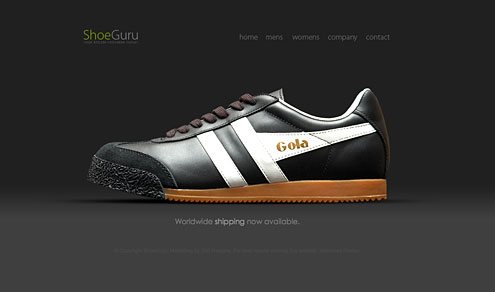
Want to encourage better conversion rates on your website (be it purchases, blog traffic, whatever) while looking good? Don’t give your readers more than a few options to choose from. By forcing them to look at what you want, you’ll enjoy more targeted traffic.
Apple does it. So does Shoe Guru. Both may be extreme, but their website design ensures them greater control over what they promote, resulting in tighter focus and better sales over the alternative, cluttered sites.
Off-topic: I’d totally buy those shoes if knew what Shoe Guru size I wear.
If you’ve never played Xbox 360, you probably missed it.
During the final action sequence of Transformers (2007), at precisely two hours, two minutes, and 25 seconds in, gamers are treated to a recognizable image and sound: a newly purchased Xbox 360 with its accompanying audio logo.
The brief product placement lasts no longer than 1 ½ seconds, as the popular console transforms on-screen into a hostile robot, after its owner becomes entangled with evil forces, while innocently shopping the streets of Las Vegas.
“I think a lot of Xbox fans got a kick out of it,” says Eli Friedman, director of Xbox Global Brand Marketing. “When we learned Transformers was being made into a movie, we jumped at the opportunity to work with Paramount Pictures since much of our core audience also happens to be Transformers fans.”
Continue reading at Edge Online…
Videogames have seen their share of forgettable taglines over the years. In 1993, Atari challenged prospective buyers to “Do the math” when considering an upgrade to their not-quite 64-bit console, the Jaguar. Gamers “did the math,” weren’t impressed, and decided to wait another year or so before upgrading to a PlayStation. Similarly, Nintendo told gamers to “Get N, or get out!” while promoting their third-generation console, the Nintendo 64- to which most people “got out” when compared to unit sales of Sony’s competing system.
But the industry has also seen its share of amusing, intelligent and effective taglines. Here are Next-Gen’s top 10 pics:
Continue reading at Edge…
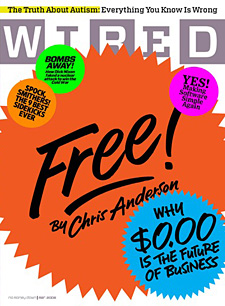 I just got done reading Chris Anderson’s 6,000 word preview for his upcoming book Free! Why $0.00 Is the Future of Business. In short, the article examines cross-subsidies (read: giving away razors to sell razor blades) as they pertain to the web products and their near-zero operating costs. You can have a free lunch so long as someone else picks up the tab, maintains Anderson.
I just got done reading Chris Anderson’s 6,000 word preview for his upcoming book Free! Why $0.00 Is the Future of Business. In short, the article examines cross-subsidies (read: giving away razors to sell razor blades) as they pertain to the web products and their near-zero operating costs. You can have a free lunch so long as someone else picks up the tab, maintains Anderson.
While the article was informative, I don’t think the strategy of giving is “the future of business,” rather it’s an effective marketing tool for select web companies — not everyone, and especially not for offline ventures. Still, Anderson presents some compelling evidence that “free” will become more ubiquitous than I currently believe.
Ironically, and in an effort to deflect the “wait a minute, your product isn’t free” criticism, Wired is offering up to 10,000 copies of its March 2008 issue at not cost to you (a fraction of the 500,000+ issues the publisher sells every month, mind you). Not quite what I’d call “practice what you preach,” but then again, I don’t think Anderson’s article endorses the demise of direct sales altogether, even if his headline does.
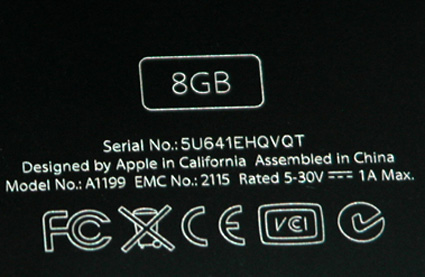
If you haven’t noticed, Apple prints “Designed by Apple in California” on the back every iPod and iPhone it sells, sometimes in a ridiculously tiny font size. Joel on Software tells why:
“These five words evoke a flurry of happy memories… Apple in California is, of course, on the literal level, a computer company, and not a very nice one, but put those words together and you think of apple orchards, and the Beatles, and you think of how Forrest Gump got rich off of Apple stock. And ‘designed in California…’ It’s not made. It’s designed. In California. Like a surfboard. Or a Lockheed XP-80.”
In short, California stands out by being the hippiest of all United States. And unlike its competitors, who outsource both product design and manufacturing overseas, Apple keeps its design rightfully in-house — at all times and at all costs. Continue reading…
Clothing designer Mark Ecko bought Barry Bond’s record-breaking 756 home run ball for $750,000. That’s cheap considering all the publicity his brand is getting.
Take it away, ESPN: “Barry Bonds thinks Marc Ecko, the man who purchased the ball from his 756th home run, is wasting his money, according to a report in the San Francisco Chronicle. Ecko, a fashion desiginer, purchased the baseball for $750,000 and is taking votes on the Internet on what he should do with it: Give the ball to the Baseball Hall of Fame, brand it with an asterisk or blast it into space.”
This story will run in every major sports section in the nation. Ecko Clothing, which targets sports fans, will see an influx of web traffic and brand interest. Sales will spike, not to mention Ecko’s mindshare, and the brilliant marketer would have done it for a measly $750,000 greenbacks.
Nice form.
 If someone told me in 1984 that you could successfully sell dolls to little boys for more than five consecutive years, I would have laughed at them. But that’s precisely what Hasbro (makers of Transfomers) and Playskool (makers of Playdough) did from 1985 into the early 90’s.
If someone told me in 1984 that you could successfully sell dolls to little boys for more than five consecutive years, I would have laughed at them. But that’s precisely what Hasbro (makers of Transfomers) and Playskool (makers of Playdough) did from 1985 into the early 90’s.
Granted, My Buddy wasn’t a smash or sustainable hit, but it clearly was profitable, albeit for a while. The lesson? Don’t let anyone tell you what you can and can’t take to market. I realize this idea encourages a lot of junk product being released, but in business, the best marketing wins, not necessarily the best product.
So the next time someone is drilling you on your marketing plan, just remember the doll intended for boys that had a run of success in the 80s. Remember My Buddy.

Brilliant! A picture truly is worth 1000 words. Via Ads of the World. Bonus: Go check out these three crazy ads from years’ past. Blowing smoke in a girl’s face used to be a turn on…? It did in advertising.
Viral marketing goes by several different names — buzz marketing, disruptive marketing, guerilla marketing, annuity effect, long tail, media leverage and even word-of-mouth marketing. But adding the word “marketing” to viral or any of the aforementioned names is a bit of a misnomer as the act of marketing typically describes a direct and conscious act on the part of companies to pitch their products to consumers. Viral marketing is anything but conscious. It is indirect marketing managed by consumers and consumers alone.
By definition, viral marketing is a phenomenon that facilitates and encourages people to pass along a marketing message, usually — though not exclusively — online. Like a literal virus, the product message gets passed along from one user to the next and is easily shared in rapid fashion. Hotmail’s mandatory “Get your private, free e-mail at Hotmail.com” message on every outgoing e-mail is widely accredited as the first viral marketing campaign. Its strategy included:
Continue reading…
See 10 cons of the Web 2.0 movement. My favorite one: “Spelling and grammr (beta) have gone to hell in a handbasket. I’m in ur domainz, droppin’ ur vowelz.”
I’m guilty (during one fleeting moment in time). Are you?
 Snarky headline aside, Seth Godin — marketing author extraordinaire — got clever with his upcoming book tour and will make a fortune from it (further solidifying his staunch marketing prowess). He’ll also avoid being stuck in Fargo, North Dakota sans book sales in the process.
Snarky headline aside, Seth Godin — marketing author extraordinaire — got clever with his upcoming book tour and will make a fortune from it (further solidifying his staunch marketing prowess). He’ll also avoid being stuck in Fargo, North Dakota sans book sales in the process.
Here’s how it works: if a state populace raises at least $25,000 in pre-purchased books (his new one), Seth will come and speak free of charge to local residents. Grass root ninjas Matt Reinbold, Phil Burns, and Jason Alba have put together an impressive local campaign that’s sure to bring the acclaimed author to Utah. If interested, click here for the salient details on how to participate, or pledge your $50 now.
See also: Seth at Google HQ discussing what I believe to be his best work, All Marketers Are Liars (It’s the storytelling, stupid.)
[Thanks to all who sent this in]
According to a survey by MediaPost, 50% of 1,100 business respondents feel that viral marketing is a fad. From the article: “A lot of people are asking for viral campaigns because they see a lot of free reach and the creators getting a lot of PR. There’s a lot of desire to do it, but viral is dependent on something big, outrageous or new… It’s hard for everybody to be outrageous, new and funny. That doesn’t mean you shouldn’t try, but it’s not appropriate for many marketers.”
It’s not a fad, it’s just severely misunderstood. Virality is indirect marketing (which most marketers don’t like and largely don’t understand how to execute), and its success is almost entirely dependent on consumers and consumers alone. That makes for a tricky and unpredictable result.
The most recent issue of Business 2.0 has a great article by Om Malik on hyperaggregation, or sites that aggregate other sites that do niche aggregation of a specific topic. For example, this blog is an aggregator of web, business, tech news, etc with a local Utah flare. My blog is also hyperaggregated by Connect Magazine that also aggregates other specific bloggers on a variety of topics though mostly focused on business issues. At some point Connect will likely post ads and start earning revenues merely by aggregating the best content. In theory, they will incur little to no content costs. The reason? People pay (in this case via attention and their time) for convenience, so as we get bombarded with even more worthwhile content, expect hyperaggregators to profitably compliment the big aggregators already out there.
Reading the article also makes me a bit sad to remember a project I was working on 9 months ago. It was an editorialized hyperaggregator built in WordPress that aimed to collect the best individual blog posts across a variety of topics. It was aptly named ContentDJ (one of the better site names I think I’ve come up with). Independent publishers signed up with our site for the chance to increase their exposure and ultimately take a cut in future ad revenues. I believe in a short few weeks with no exposure resulted in several hundred independent publishers. Sadly, my funding got cut, the site never left Alpha, and I currently don’t have the resources to keep it going though I still plan on seeing it realized.
On a related note, Griffio won a small account with Podango a few weeks ago to build a website for their newly launched Latest At… service which hyperaggregates the best of the best on big social websites like YouTube, MySpace, even PerezHilton.com. So take note: hyperaggretion will likely do very well in the coming months.
I just overheard a television commercial for a local liposuction practice. The commercial tagline really caught me by surprise: “It’s your body, you select it.” It sounded really good (which is what an advertisement is suppose to do) but it’s a complete lie. Just because it’s your body doesn’t mean you hold the key to modify your DNA. Not even good marketing can change that. This isn’t to say that liposuction is wrong in any way. I’m just commenting that despite what marketers would have you believe, you cannot change your physical appearance with money to complete satisfactory levels. In nearly every case, that comes from within. But when my kids hit adolescence and struggle with their appearance like every other human being does, I’ll just lie to them: “It’s your body, you select.” That was easy.
A blog can be an excellent tool for building “You Inc.” For those out of the loop, a blog is nothing more than an easily updateable Web site intended to inform or influence. Here are eight things to avoid while blogging to help attract site visitors, garner trust, heighten exposure and increase revenues. Continue reading…
I’m currently reading Love is The Killer App. Though not the most prolific business book, the title does an excellent job in formulating what makes for a successful business career in terms of happiness and producing a return on your “networks.” Author Tim Sanders defines a “lovecat” as an individual that intelligently and sensibly shares his/her knowledge, network of friends and associates, and compassionate service with bizpartners without expecting anything in return.
What’s a bizpartner you may ask? Every person in our work life, be it a boss, banker, competitor, client, or just about anyone else. I especially like the competitor one and have recently discovered how much of an asset and help they can be for any type of business striving to improve.
Continue reading…




 I’ve purchased a lot of product in my life. And if there’s one selling point that gets me more than anything else, it’s something that’s “built from the ground up.”
I’ve purchased a lot of product in my life. And if there’s one selling point that gets me more than anything else, it’s something that’s “built from the ground up.”
 After Tiger Woods took “extramarital affairs” to new lows this year, numerous sponsors canceled their contracts with the once role model, including
After Tiger Woods took “extramarital affairs” to new lows this year, numerous sponsors canceled their contracts with the once role model, including 

 I just got done reading Chris Anderson’s 6,000 word preview for his upcoming book
I just got done reading Chris Anderson’s 6,000 word preview for his upcoming book 


